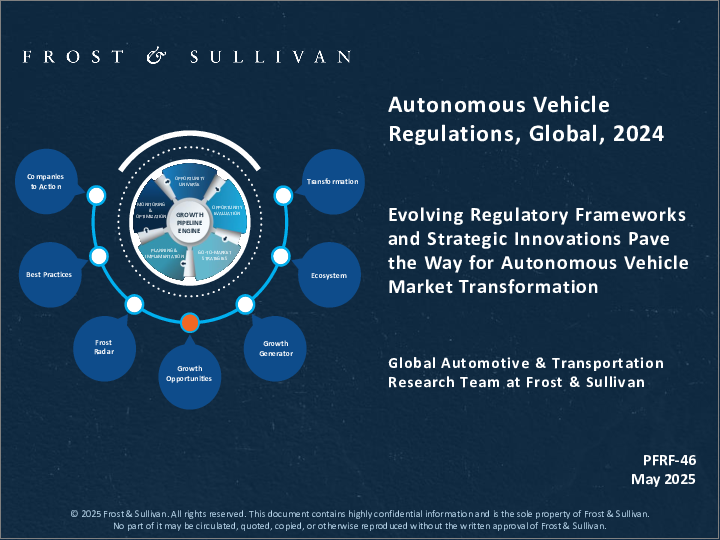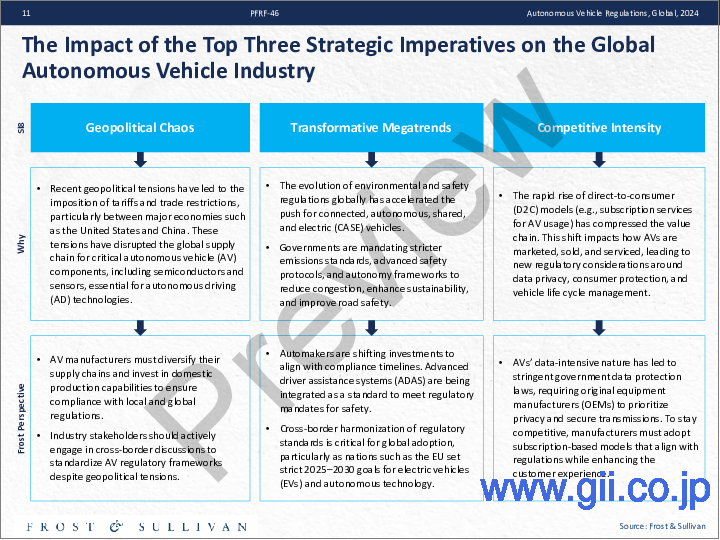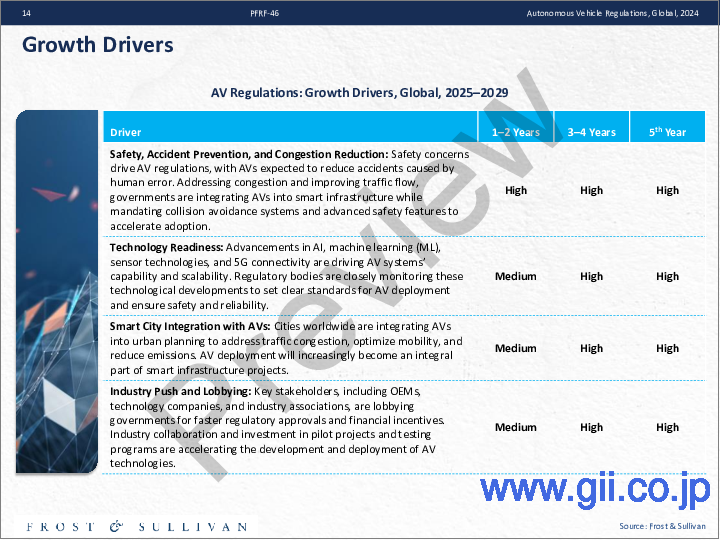|
|
市場調査レポート
商品コード
1750749
世界の自律走行車(AV)規制、2024年Autonomous Vehicle Regulations, Global, 2024 |
||||||
|
|||||||
| 世界の自律走行車(AV)規制、2024年 |
|
出版日: 2025年05月13日
発行: Frost & Sullivan
ページ情報: 英文 67 Pages
納期: 即日から翌営業日
|
- 全表示
- 概要
- 目次
進化する規制の枠組みと戦略的イノベーションが自律走行車(AV)市場のトランスフォーメーションへの道を開く
本調査は、2024年における世界の自律走行車(AV)規制の戦略的分析を提供し、地域間の試験における主な発展、地域力学、AVエコシステムを形成する枠組みにハイライトを当てています。北米、欧州、アジア太平洋(APAC)、新興市場における法規制の進展と試験の取り組みを検証しています。米国の規制状況は依然として断片的で、州ごとに異なる法律が運用上の矛盾を生み出している一方、欧州は国境を越えた試験と厳格な安全プロトコルで先行しています。中国、日本、シンガポールを含むアジア太平洋諸国は、政府の政策とスマートシティの進展に後押しされ、レベル4とレベル5の試験に秀でています。ドイツと日本は、レベル3の自動車線維持システムの消費者利用を規制しており、レベル4の採用を加速するための規制を起草中です。UNECEやNHTSAなどの国際機関は、世界標準の調和を図っています。ロボットタクシーは、管理された環境で選択的に導入されていますが、レベル5の完全な導入には、技術面、規制面、そして社会受容性に関するマイルストーンの達成が待たれています。本調査は、AVイノベーションと市場成長を形成する多様な規制アプローチ、課題、機会に関する見識を関係者に提供します。
目次
戦略的インペラティブ
- なぜ成長が難しくなっているのか?
- The Strategic Imperative 8(TM)
- 世界の自律走行車(AV)業界に対する戦略的インペラティブトップ3の影響
成長機会分析
- 分析範囲
- 成長促進要因
- 成長抑制要因
世界のAV規制
- AV規制の概要 - 世界
- AV規制・試験情勢の概要 - 欧州
- AV規制・試験情勢の概要 - アジア太平洋・中国
- AV規制・試験情勢の概要 - 北米
- 欧州のAV試験情勢
- アジア太平洋の主要国のAV試験情勢
- 北米のAV規制の枠組み
定義
- SAE Internationalによる自動運転レベルの定義
AV規制 - 欧州
- UNECE AVガイドラインの枠組み
- UNECE 自律走行機能の展開に対する規制
- ACEA 自動運転・自律走行ロードマップ
- 規制の概要 - 欧州(最も進化)
- 規制の概要 - 欧州(中程度・最小の進化)
- 規制の概要 - オーストリア
- 規制の概要 - ベルギー
- 規制の概要 - デンマーク
- 規制の概要 - フランス
- 規制の概要 - ドイツ
- 規制の概要 - ギリシャ
- 規制の概要 - イタリア
- 規制の概要 - 英国
- その他の欧州諸国の規制の枠組み
- 欧州のAV試験情勢
AV規制 - アジア太平洋
- 規制の概要 - アジア太平洋
- 規制の概要 - 中国
- 中国のロボットタクシー実証プロジェクトと参入企業
- 中国のICV導入に対する政府の取り組み
- 中国のICV早期展開を促進するスマートシティプロジェクト
- 中国のICV展開に対する自動運転OEMの戦略的投資
- 規制の概要 - 日本
- 規制の概要 - シンガポール
- 規制の概要 - マレーシア
- 規制の概要 - 韓国
- 規制の概要 - オーストラリア
- 規制の概要 - ニュージーランド
- 規制の概要 - インド
- アジア太平洋の主要国のAV試験情勢・展開
AV規制 - 北米
- 規制の概要 - 北米
- 米国のADSに対するNHTSAの枠組み
- 米国の連邦・州の規制当局の役割
- 米国の戦略的AV開発・展開に対するロードマップ
- 米国のAV試験・展開の規制
- 北米のAV規制の枠組み
- 米国のAV規制の枠組み
- 規制の概要 - カナダ
- 規制の概要 - AV試験の規制
- 規制の概要 - メキシコ
- 北米のAV乗用車の公的試験プロジェクト
- 北米の遠隔操作の規制
- 米国の遠隔操作の規制
L3・L4車両の主要参入企業
- L3車両の主要参入企業
- L4ロボットタクシー主要参入企業
成長機会ユニバース
- 成長機会1:規制による差別化でプレミアム車両のイノベーションを推進
- 成長機会2:L4車両の運用化によるユースケースの拡大
- 成長機会3:L2+・L3車両のスケールアップによる普及拡大
- 成長機会4:規制の調和による試験・展開の合理化
結論
- 要点
- 略語・頭字語リスト(一部)
付録と次のステップ
- 成長機会の利益と影響
- 次のステップ
- 資料リスト
- 免責事項
Evolving Regulatory Frameworks and Strategic Innovations Pave the Way for Autonomous Vehicle Market Transformation
This study provides a strategic analysis of global autonomous vehicle (AV) regulations in 2024, highlighting key developments in testing across regions, regional dynamics, and frameworks shaping the AV ecosystem. It examines legislative progress and testing initiatives across North America, Europe, Asia-Pacific (APAC), and emerging markets. The US regulatory landscape remains fragmented, with state-specific laws creating operational inconsistencies, while Europe leads with cross-border testing and stringent safety protocols. APAC nations, including China, Japan, and Singapore, excel in Level 4 and Level 5 testing, driven by government policies and smart city advancements. Germany and Japan have regulated consumer use of Level 3 automated lane keeping systems and are drafting regulations to accelerate Level 4 adoption. International bodies, such as the UNECE and the NHTSA, are harmonizing global standards. Robotaxis are selectively deployed in controlled settings, while full Level 5 deployment awaits technological, regulatory, and public acceptance milestones. This study equips stakeholders with insights into diverse regulatory approaches, challenges, and opportunities shaping AV innovation and market growth.
Scope of Analysis
- The AV market is growing in the United States, China, and Europe, but it is still in the early stages of development in many countries in Asia-Pacific (APAC).
- While AV development and testing have reached higher levels of autonomy, such as Level 4 (L4; highly autonomous) and Level 5 (L5; fully autonomous), L4 technologies have seen selective deployment. Robotaxis and autonomous shuttles operate in various cities under controlled conditions. Full deployment of L5 AVs remains a future goal, reliant on technological breakthroughs, comprehensive regulatory frameworks, and public acceptance.
- Global regulations favoring testing and deployment will determine the adoption timeline for consumer markets. Germany and Japan have regulated consumer use of Level 3 (L3) automated lane keeping systems (ALKS), enabling early market adoption of ALKS in these countries. In addition, these countries have proposed draft regulations for L4 systems to foster higher adoption rates.
- International regulatory bodies, such as the United Nations Economic Commission for Europe (UNECE) and the US' National Highway Traffic Safety Administration (NHTSA), are driving global frameworks for AVs. UNECE's Regulation No. 157 enables L3 ALKS, while recent updates, such as the 2024 Driver Control Assistance Systems (DCAS) rules, further align automation standards. These efforts aim to harmonize L3-L5 deployment, build consumer trust, and accelerate global adoption.
- This study analyzes the regulatory framework for AV testing and deployment in Europe, North America, and APAC, covering 27 countries, including China.
The Impact of the Top Three Strategic Imperatives on the Global Autonomous Vehicle Industry
Geopolitical Chaos
Why
Recent geopolitical tensions have led to the imposition of tariffs and trade restrictions, particularly between major economies such as the United States and China. These tensions have disrupted the global supply chain for critical autonomous vehicle (AV) components, including semiconductors and sensors, essential for autonomous driving (AD) technologies.
Frost Perspective
AV manufacturers must diversify their supply chains and invest in domestic production capabilities to ensure compliance with local and global regulations.
Industry stakeholders should actively engage in cross-border discussions to standardize AV regulatory frameworks despite geopolitical tensions.
Transformative Megatrends
Why
The evolution of environmental and safety regulations globally has accelerated the push for connected, autonomous, shared, and electric (CASE) vehicles.
Governments are mandating stricter emissions standards, advanced safety protocols, and autonomy frameworks to reduce congestion, enhance sustainability, and improve road safety.
Frost Perspective
Automakers are shifting investments to align with compliance timelines. Advanced driver assistance systems (ADAS) are being integrated as a standard to meet regulatory mandates for safety.
Cross-border harmonization of regulatory standards is critical for global adoption, particularly as nations such as the EU set strict 2025-2030 goals for electric vehicles (EVs) and autonomous technology.
Competitive Intensity
Why
The rapid rise of direct-to-consumer (D2C) models (e.g., subscription services for AV usage) has compressed the value chain. This shift impacts how AVs are marketed, sold, and serviced, leading to new regulatory considerations around data privacy, consumer protection, and vehicle life cycle management.
Frost Perspective
AVs' data-intensive nature has led to stringent government data protection laws, requiring original equipment manufacturers (OEMs) to prioritize privacy and secure transmissions. To stay competitive, manufacturers must adopt subscription-based models that align with regulations while enhancing the customer experience.
Growth Drivers
- Safety, Accident Prevention, and Congestion Reduction: Safety concerns drive AV regulations, with AVs expected to reduce accidents caused by human error. Addressing congestion and improving traffic flow, governments are integrating AVs into smart infrastructure while mandating collision avoidance systems and advanced safety features to accelerate adoption.
- Technology Readiness: Advancements in AI, machine learning (ML), sensor technologies, and 5G connectivity are driving AV systems' capability and scalability. Regulatory bodies are closely monitoring these technological developments to set clear standards for AV deployment and ensure safety and reliability.
- Smart City Integration with AVs: Cities worldwide are integrating AVs into urban planning to address traffic congestion, optimize mobility, and reduce emissions. AV deployment will increasingly become an integral part of smart infrastructure projects.
- Industry Push and Lobbying: Key stakeholders, including OEMs, technology companies, and industry associations, are lobbying governments for faster regulatory approvals and financial incentives. Industry collaboration and investment in pilot projects and testing programs are accelerating the development and deployment of AV technologies.
Growth Restraints
- Liability and Legal Frameworks: Determining liability in the event of an AV-related accident is a significant challenge, as traditional laws do not account for autonomous decision-making systems. Governments are working to establish clear legal frameworks that address manufacturer, operator, and user responsibility, delaying large-scale regulatory approval.
- Security and Data Privacy Concerns: AVs generate vast amounts of data, raising concerns about cybersecurity threats, data misuse, and consumer privacy. Governments are hesitant to approve widespread AV deployment without robust security frameworks and assurances against hacking or malicious exploitation of connected systems.
- Economic Disruption and Job Loss Concerns: Governments are cautious about enabling widespread AV deployment due to fears of mass job displacement in sectors such as trucking, taxi services, and public transportation. The political and social backlash from affected industries and workers poses a significant challenge for policymakers, slowing regulatory progress.
- Public Safety and Trust Deficit: Governments are concerned about the public perception of AV safety, especially in light of incidents during testing phases. This has led to hesitancy in allowing broad deployment without sufficient real-world validation. Ensuring public safety through robust testing and phased rollouts is critical before gaining regulatory approvals.
Table of Contents
Autonomous Vehicle Regulations, Global, 2024 PFRF-
Strategic Imperatives
- Why is it Increasingly Difficult to Grow?
- The Strategic Imperative 8™
- The Impact of the Top Three Strategic Imperatives on the Global Autonomous Vehicle Industry
Growth Opportunity Analysis
- Scope of Analysis
- Growth Drivers
- Growth Restraints
Global AV Regulations
- AV Regulatory Overview-Global
- AV Regulations and Testing Landscape Overview-Europe
- AV Regulations and Testing Landscape Overview-APAC and China
- AV Regulations and Testing Landscape Overview-North America
- AV Testing Landscape in Europe
- AV Testing Landscape in Key APAC Countries
- AV Regulatory Framework in North America
Definitions
- SAE International's Definition of Levels of Driving Automation
AV Regulations-Europe
- UNECE Framework for AV Guidelines
- UNECE Regulations for Autonomous Feature Deployment
- ACEA Automated and Autonomous Roadmap
- Regulatory Overview-Europe Most Evolved
- Regulatory Overview-Europe Moderately and Least Evolved
- Regulatory Overview-Austria
- Regulatory Overview-Belgium
- Regulatory Overview-Denmark
- Regulatory Overview-France
- Regulatory Overview-Germany
- Regulatory Overview-Greece
- Regulatory Overview-Italy
- Regulatory Overview-United Kingdom
- Regulatory Framework of Other European Countries
- AV Testing Landscape in Europe
AV Regulations-APAC
- Regulatory Overview-APAC
- Regulatory Overview-China
- Robotaxi Testing Projects and Participants in China
- Government Initiatives for ICV Adoption in China
- Smart City Projects to Foster Early ICV Deployment in China
- Autonomous Driving OEMs' Strategic Investments in ICV Deployments in China
- Regulatory Overview-Japan
- Regulatory Overview-Singapore
- Regulatory Overview-Malaysia
- Regulatory Overview-South Korea
- Regulatory Overview-Australia
- Regulatory Overview-New Zealand
- Regulatory Overview-India
- AV Testing Landscape and Deployment in Key APAC Countries
AV Regulations-North America
- Regulatory Overview-North America
- NHTSA Framework for ADS in the United States
- US Federal and State Regulatory Roles
- US Roadmap for Strategic AV Development and Deployment
- AV Testing and Deployment Regulations in the United States
- AV Regulatory Framework in North America
- AV Regulatory Framework in the United States
- Regulatory Overview-Canada
- Regulatory Overview-AV Testing Regulations
- Regulatory Overview-Mexico
- Public Testing Projects for AVs Passenger Cars in North America
- Teleoperation Regulations in North America
- Teleoperation Regulations in the United States
Key L3 and L4 Vehicle Participants
- Key L3 Vehicle Participants
- Key L4 Robotaxi Participants
Growth Opportunity Universe
- Growth Opportunity 1: Differentiating Through Mandates Driving Innovation in Premium Vehicles
- Growth Opportunity 2: Operationalizing L4 Vehicles for Expanded Use Cases
- Growth Opportunity 3: Scaling L2+ and L3 Vehicles for Broader Adoption
- Growth Opportunity 4: Harmonizing Regulations to Streamline Testing and Deployment
Conclusion
- Key Takeaways
- Partial List of Abbreviations and Acronyms Used in the Study
Appendix & Next Steps
- Benefits and Impacts of Growth Opportunities
- Next Steps
- List of Exhibits
- Legal Disclaimer






